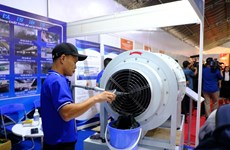Apparel industry needs redesign
The Vietnam textile and garment sector must make fundamental changes to
develop sustainably as part of the global textile and garment chain,
agreed participants in a conference in the southern province of
Tien Giang on June 7.
The Vietnam textile and garment sector must make fundamental changes to
develop sustainably as part of the global textile and garment chain,
agreed participants in a conference in the southern province of
Tien Giang on June 7.
First, the sector needs to develop a support industry that would produce raw materials domestically, reducing reliance on imported materials.
Additionally, it should develop the design industry, reduce processing, increase the localisation rate and reduce imports, which would in turn decrease manufacturing costs and dependence on foreign partners.
Enterprise representatives said the government should review and update the existing textile and garment strategy and build exclusive industrial zones for the sector.
They also planned to focus on developing a domestic textile and dyeing industry and joining the supply chain to export markets - especially the US market – as well as increasing the added value of garment products and developing further in the domestic market.
As for the Trans-Pacific Partnership Agreement (TPP), a free trade agreement that aims to integrate the economies of the Asia-Pacific region, the Vietnam National Apparel Association expects the agreement to benefit Vietnam's economy because the member countries offered preferential import tax rates for key export sectors in Vietnam, including textiles and garments.
However, this agreement would also bring challenges to the sector. Domestic enterprises would be required to import raw materials from TPP members, a major adjustment given that the domestic textile and garment industry currently imports 90 percent of materials from non-TPP countries.
In 2012, Vietnam's garment industry earned 20 billion USD in revenue, including 17 billion USD from exports. Half the exports were shipped to the US and the remainder to European countries, Japan and the Republic of Korea.
The industry needed 415,000 tonnes of cotton for production, while domestic producers could only supply 5,000 tonnes. Similarly, out of the needed 6.8 billion metres of cloth, 6 billion metres were imported.
More than 40 textile enterprises from the provinces of Tien Giang, Long An, Vinh Long, Ben Tre, An Giang and Dong Thap attended the conference, which was organised by the Vietnam National Apparel Association and the Tien Giang People's Committee-VNA
First, the sector needs to develop a support industry that would produce raw materials domestically, reducing reliance on imported materials.
Additionally, it should develop the design industry, reduce processing, increase the localisation rate and reduce imports, which would in turn decrease manufacturing costs and dependence on foreign partners.
Enterprise representatives said the government should review and update the existing textile and garment strategy and build exclusive industrial zones for the sector.
They also planned to focus on developing a domestic textile and dyeing industry and joining the supply chain to export markets - especially the US market – as well as increasing the added value of garment products and developing further in the domestic market.
As for the Trans-Pacific Partnership Agreement (TPP), a free trade agreement that aims to integrate the economies of the Asia-Pacific region, the Vietnam National Apparel Association expects the agreement to benefit Vietnam's economy because the member countries offered preferential import tax rates for key export sectors in Vietnam, including textiles and garments.
However, this agreement would also bring challenges to the sector. Domestic enterprises would be required to import raw materials from TPP members, a major adjustment given that the domestic textile and garment industry currently imports 90 percent of materials from non-TPP countries.
In 2012, Vietnam's garment industry earned 20 billion USD in revenue, including 17 billion USD from exports. Half the exports were shipped to the US and the remainder to European countries, Japan and the Republic of Korea.
The industry needed 415,000 tonnes of cotton for production, while domestic producers could only supply 5,000 tonnes. Similarly, out of the needed 6.8 billion metres of cloth, 6 billion metres were imported.
More than 40 textile enterprises from the provinces of Tien Giang, Long An, Vinh Long, Ben Tre, An Giang and Dong Thap attended the conference, which was organised by the Vietnam National Apparel Association and the Tien Giang People's Committee-VNA













